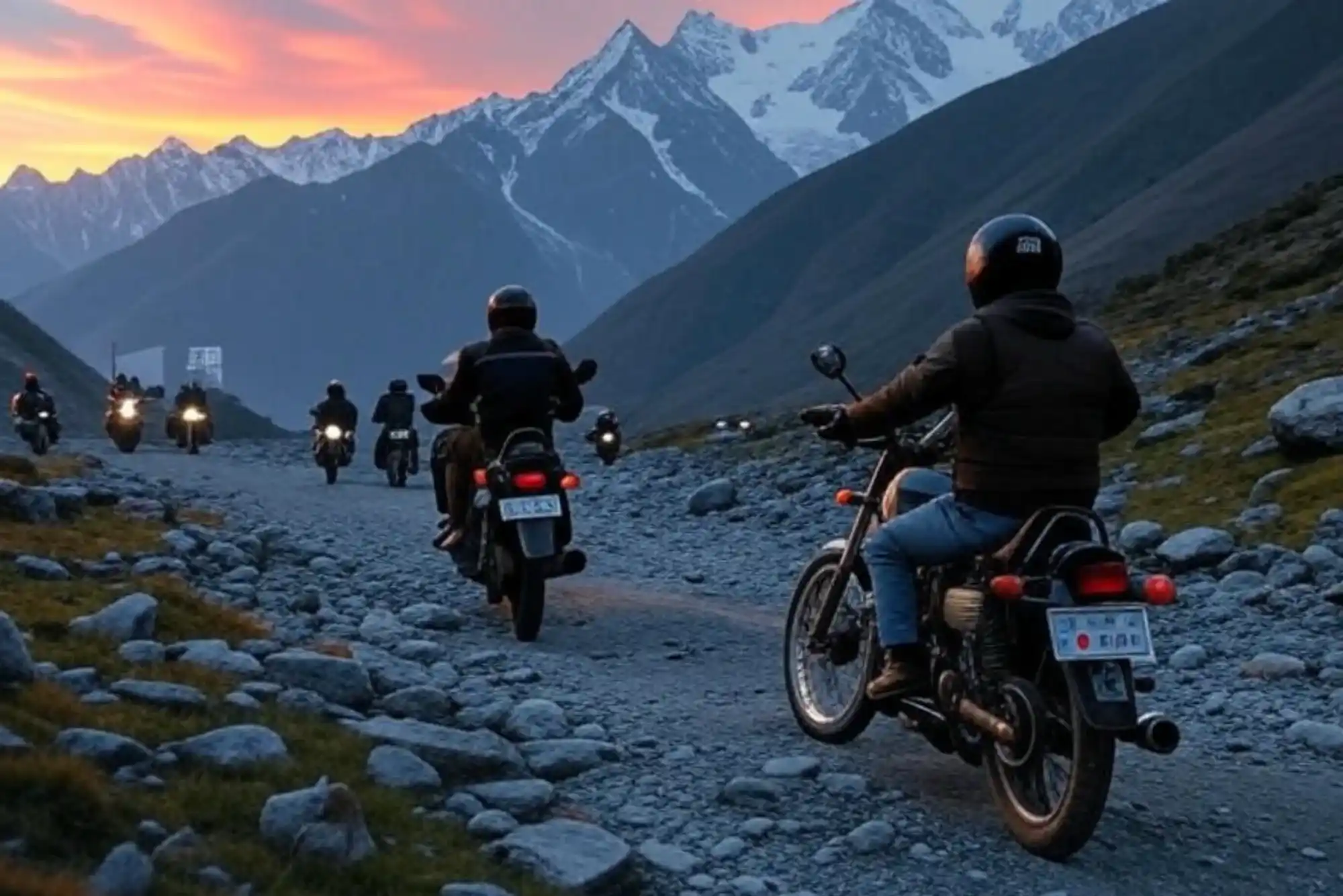There are motorcycle tours—and then there’s the motorcycle tour Himalaya riders whisper about with reverence. Towering peaks, remote mountain passes, and narrow cliff-hugging roads—this isn’t your average road trip. It’s an adventure where the air gets thin, the scenery grows wild, and the road becomes more than just asphalt. It becomes a test of spirit.
So is it really worth the hype, the cold, and the challenges? If you’ve ever felt the tug of the mountains calling, then the Himalayas might just be your ultimate ride.
What Makes the Himalayas a Legendary Motorcycle Destination?
The Epic Terrain
Few places on Earth offer such dramatic variation in elevation and environment. One day you’re riding through pine forests, the next you’re crossing arid, wind-swept passes over 17,000 feet high. This constant change is what keeps the journey fresh—and often, unforgettable.
The Sense of Adventure
Let’s be clear: a motorcycle tour Himalaya is no leisurely cruise. It’s challenging. But that’s also what makes it deeply rewarding. You’ll cross high-altitude deserts, navigate rocky roads, dodge landslides, and maybe even help a fellow rider repair a clutch cable by the roadside. It’s raw, real, and thrilling.
The Cultural Encounters
Whether it’s sipping butter tea with a Ladakhi monk, camping with locals in Spiti Valley, or passing a prayer flag-strewn stupa, the human connection in the Himalayas is strong. These mountains are home to people whose warmth contrasts beautifully with the cold air around you.
What Are the Best Routes for a Motorcycle Tour in the Himalayas?
Leh–Ladakh Circuit
Arguably the most iconic Himalayan motorcycle route. Riders usually start in Manali and head toward Leh via Rohtang Pass and Baralacha La, continuing to places like Nubra Valley, Pangong Lake, and Khardung La—the (disputed) highest motorable road in the world.
Duration: 10–14 days
Best Time: June to September
Spiti Valley Circuit
Rugged, remote, and less commercial than Ladakh. The ride from Shimla to Kaza through Kalpa, Tabo, and Chandratal offers some of the most Martian-looking terrain on Earth.
Duration: 10–12 days
Best Time: June to October
Srinagar–Leh Route
An alternate path to Ladakh with a different flavor. Instead of starting in Himachal, you approach Leh via Kashmir, crossing the beautiful Zoji La Pass and visiting Drass and Kargil on the way.
Duration: 5–7 days
Best Time: July to September
Sikkim and North East India
The Eastern Himalayas offer lush green valleys, Buddhist monasteries, and misty mountain roads. Ride from Gangtok to Yumthang or Nathula Pass for a very different Himalayan vibe.
Duration: 5–10 days
Best Time: March to June or September to November
Should You Go With a Tour Company or Ride Independently?
Guided Tours
Ideal for first-time riders in the region or anyone who doesn’t want to deal with logistics. Reputable tour companies handle bike maintenance, lodging, permits, backup vehicles, and sometimes even medical support.
Pros: Stress-free, safer, community vibe
Cons: Less flexible, higher cost
Independent Travel
If you like freedom and spontaneity, renting or bringing your own bike and figuring it out on the go can be deeply rewarding.
Pros: Maximum freedom, more adventurous
Cons: Riskier, you handle breakdowns and permits
Tip: Many riders pair up through online forums or Facebook groups before heading into the Himalayas.
What Kind of Motorcycle Is Best for the Himalayas?
The Himalayas demand a bike that can handle rough terrain, altitude, and long days on the road.
Royal Enfield Himalayan (411cc): Built for these mountains. Excellent suspension and torque.
Royal Enfield Classic 350/500: A bit more classic than practical, but still widely used.
Hero Xpulse 200: Lightweight and nimble, great for off-road sections.
KTM Adventure or BMW GS: Premium options for experienced adventure riders.
Pro Tip: Choose reliability over flash. Spare parts availability matters more than horsepower up here.
What Should You Pack for a Motorcycle Tour in the Himalayas?
Packing light—but smart—is essential.
Warm Layers: It gets freezing, even in summer. Bring thermal gear and a windproof jacket.
Riding Gear: Helmet (DOT certified), gloves, armored jacket and pants, and waterproof boots.
Rain Protection: A good rain suit can be a lifesaver.
Basic Tools: Multi-tool, tire repair kit, spark plug, zip ties, and duct tape.
Health Essentials: Acetazolamide for altitude sickness, painkillers, water purification tablets.
Documents: Driver’s license (IDP if needed), vehicle papers, permits (especially for areas like Nubra and Pangong).
How Do You Deal With Altitude and Weather?
Altitude Sickness
Anything above 10,000 feet can cause issues. Common symptoms include headaches, nausea, and dizziness.
Tips:
Ascend gradually when possible
Stay hydrated and avoid alcohol
Take acclimatization days
Carry medicine like Diamox
Weather
The weather in the Himalayas can shift dramatically in minutes. Sun, snow, rain, and wind might all occur on the same day.
Key Advice:
Always start early, check local forecasts, and never underestimate how cold it can get—even in June.
Is It Safe to Ride in the Himalayas?
Riding here is not without risk, but it’s manageable with preparation and awareness.
Hazards Include:
Landslides: Especially during the monsoon. Don’t rush past blocked sections.
Road Conditions: Expect gravel, ice, potholes, and streams crossing roads.
Remote Breakdowns: Carry spares and know basic repair techniques.
What Helps:
Ride in a group or at least let someone know your route.
Mobile signals are sparse, but BSNL often works in remote areas.
Locals are incredibly helpful—don’t hesitate to ask for assistance.
Real Rider Story: “Why I’ll Never Forget the Ride to Pangong Lake”
A friend of mine, Harish, joined a motorcycle tour in the Himalayas after losing his job during the pandemic. What started as a break turned into a spiritual reset. “It wasn’t just about riding,” he told me. “It was about rediscovering what mattered.”
His group got caught in a snowstorm near Chang La Pass, and they had to dig their bikes out with makeshift shovels. Locals brought them chai and lent space in a tiny hut. It was uncomfortable, cold, and chaotic. But when they finally reached Pangong Lake under a clear blue sky, it was magic. “I cried a little,” he admitted. “It felt earned.”
What Makes This Tour So Life-Changing?
A motorcycle tour Himalaya isn’t a vacation—it’s a transformation. There’s something about the altitude, the minimalism, and the challenge that strips life down to its essentials. You notice the little things: a warm fire, the sound of prayer flags in the wind, the crunch of gravel under your tires.
Every rider I’ve met who tackled the Himalayas came back changed. Stronger. Calmer. Hungrier for more.
Final Thoughts: Is a Motorcycle Tour in the Himalayas Worth It?
Without a doubt.
It’s not for the faint-hearted, but for those who crave adventure, self-discovery, and jaw-dropping beauty, it’s one of the most powerful journeys you can take. You’ll battle the elements, bond with strangers, and carry memories etched into every curve of the road.
So yes—the motorcycle tour Himalaya is worth it. More than worth it. It’s the kind of ride that becomes a story you tell for the rest of your life.











